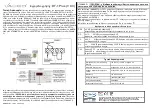
User’s Manual U16898EJ3V0UD
66
CHAPTER 5 CLOCK GENERATORS
5.1 Functions of Clock Generators
The clock generators include a circuit that generates a clock (system clock) to be supplied to the CPU and
peripheral hardware, and a circuit that generates a clock (interval time generation clock) to be supplied to the
watchdog timer and 8-bit timer H1 (TMH1).
5.1.1 System clock oscillators
The following three types of system clock oscillators are used.
•
High-speed internal oscillator
This circuit internally oscillates a clock of 8 MHz (TYP.). Its oscillation can be stopped by execution of the STOP
instruction.
If the high-speed internal oscillator is selected to supply the system clock, the X1 and X2 pins can be used as I/O
port pins.
•
Crystal/ceramic oscillator
This circuit oscillates a clock with a crystal/ceramic oscillator connected across the X1 and X2 pins. It can
oscillate a clock of 1 to 10 MHz. Oscillation of this circuit can be stopped by execution of the STOP instruction.
•
External clock input circuit
This circuit supplies a clock from an external IC to the X1 pin. A clock of 1 to 10 MHz can be supplied. Internal
clock supply can be stopped by execution of the STOP instruction.
If the external clock input is selected as the system clock, the X2 pin can be used as an I/O port pin.
The system clock source is selected by using the option byte. For details, refer to
CHAPTER 17 OPTION BYTE
.
When using the X1 and X2 pins as I/O port pins, refer to
CHAPTER 4 PORT FUNCTIONS
for details.
5.1.2 Clock oscillator for interval time generation
The following circuit is used as a clock oscillator for interval time generation.
•
Low-speed internal oscillator
This circuit oscillates a clock of 240 kHz (TYP.). Its oscillation can be stopped by using the low-speed internal
oscillation mode register (LSRCM) when it is specified by the option byte that its oscillation can be stopped by
software.
















































